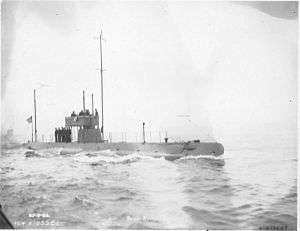United States E-class submarine
 USS E-1, lead ship of the class | |
| Class overview | |
|---|---|
| Name: | E class |
| Builders: |
|
| Operators: |
|
| Preceded by: | D class |
| Succeeded by: | F class |
| Built: | 1911-1912 |
| In commission: | 1912-1921 |
| Completed: | 2 |
| Retired: | 2 |
| General characteristics | |
| Type: | Submarine |
| Displacement: |
|
| Length: | 135 ft 3 in (41.22 m) |
| Beam: | 14 ft 7 in (4.45 m) |
| Draft: | 11 ft 8 in (3.56 m) |
| Propulsion: |
|
| Speed: |
|
| Range: |
|
| Test depth: | 200 ft (61 m) |
| Complement: | 20 |
| Armament: |
|
The E-class submarines were a class of two United States Navy submarines, built by the Fore River Shipbuilding Company of Quincy, Massachusetts under a subcontract from the Electric Boat Company. They were used as coastal and harbor defense submarines prior to World War I. When hostilities broke out, the E class were mostly used as training boats; however, E-1 operated on war patrols based in the Azores. During this time, the need for an improved permanent bridge structure was discovered; the temporary piping-and-canvas bridges were inadequate in the North Atlantic.
Design
Unusually for the early submarine era, the E class were the same size as the preceding D class at 340 tons submerged. The E class were the first US diesel-powered submarines (the French "Z" (Q 36) was the first worldwide in 1905).[2] Although the early diesels were unreliable and the E class were re-engined in 1915, diesels rapidly became the standard engine for submarines worldwide. The fuel is much less flammable than the gasoline used in previous submarines. Today, nuclear-powered submarines continue to have a backup diesel engine. Another innovation that became standard was bow planes for more precise underwater control.[1]
These vessels included some features intended to increase underwater speed that were standard on US submarines of this era, including a small sail and a rotating cap over the torpedo tube muzzles. For extended surface runs, the small sail was augmented with a temporary piping-and-canvas structure (see photo). Apparently the "crash dive" concept had not yet been thought of, as this would take considerable time to deploy and dismantle. This remained standard through the N class, commissioned 1917-1918. Experience in World War I showed that this was inadequate in the North Atlantic weather, and earlier submarines serving overseas in that war (E class through L class) had their bridge structures augmented with a "chariot" shield on the front of the bridge. Starting with the N class, built with lessons learned from overseas experience, US submarines had bridges more suited to surfaced operations in rough weather. The streamlined, rotating torpedo tube muzzle cap eliminated the drag that muzzle holes would otherwise cause. In the stowed position, the submarine appears to have no torpedo tubes, as the holes in the cap are covered by the bow stem. This feature remained standard through the K class, after which it was replaced with shutters that were standard through the 1950s.
History
The E class and similar early submarines were known as "pig boats", or "boats", due to foul living quarters and unusual hull shape.[3] The E class was used to test and evaluate tactics and new equipment, but was quickly overtaken by newer long-range, ocean-going submarines. E-1 was forward deployed to the Azores in World War I, the oldest and smallest US submarine to perform war patrols in that war. The class was decommissioned and scrapped in 1922 to comply with the Washington Naval Treaty.
Boats
- USS E-1 (SS-24) was launched on 27 May 1911 as Skipjack and was commissioned on 14 February 1912 (LT Chester W. Nimitz in command). Renamed E-1 on 17 November 1911 and reclassified as SS-24 on 17 July 1920, the submarine was decommissioned on 20 October 1921 and sold afterwards.[4]
- USS E-2 (SS-25) was launched on 15 June 1911 as Sturgeon and was commissioned on 14 February 1912. Renamed E-2 on 17 November 1911 and reclassified as SS-24 on 17 July 1920, the submarine was decommissioned on 20 October 1921 and sold afterwards.[5]
References
Notes
Sources
- Submarines, War Beneath The Waves, From 1776 To The Present Day, By Robert Hutchinson.
- Gardiner, Robert, Conway's all the world's fighting ships 1906-1921 Conway Maritime Press, 1985. ISBN 0-85177-245-5.
- Friedman, Norman "US Submarines through 1945: An Illustrated Design History", Naval Institute Press, Annapolis:1995, ISBN 1-55750-263-3.
- Navsource.org early diesel submarines page
- Pigboats.com E-boats page
External links
![]() Media related to E class submarines of the United States at Wikimedia Commons
Media related to E class submarines of the United States at Wikimedia Commons
| ||||||||||||||||||||||||||||||||||||||||||||||